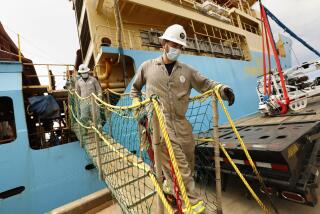Speaking Of: : Coral Reefs : Marine Habitats Under Global Assault
- Share via
Earth’s remarkable coral reefs are under attack. Pollution, overfishing and development threaten to destroy this fragile, beautiful system of marine life. Silt from construction and agriculture on coastal lands smothers the reefs. Increasing sea traffic covers the coral with poisonous pollutants. “Dynamite fishers” use explosives to kill or stun fish for an easy catch, blowing up sections of the reefs in the process.
To protect these natural wonders from further damage, several countries have begun regulating activities in regions with reefs. Australia, for example, has designated as a national park most of the Great Barrier Reef, banning coral hunting, oil drilling and polluting activities.
Coral reefs--typified by an explosion of color--are a biological treasure featuring a variety of species and ecosystems rivaled in number only by those found in tropical rain forests.
The reefs, some estimated to be 30 million years old, in total cover an area roughly the size of Texas. The Great Barrier Reef, which extends in broken chains for nearly 1,250 miles, can be seen from the moon.
THREATS TO REEFS AND REEF INHABITANTS
Reefs need sunshine and clear, nutrient-laden warm water to survive and therefore are found only in shallow waters along a band extending 30 degrees north and south of the Equator. Because shallow water is necessary, reefs are located near land and are susceptible to changes that take place on land.
Among the land-based and man-made threats to reef survival are deforestation, coastal development and tourism, shipping, oil spills, overfishing or fishing with explosives, coral mining and overharvesting of reef species.
Map shows the status of the world’s major coral reefs and the threats they currently face. Percentages in parenthesis indicate the proportion of the Earth’s total reef area found in the region.
Atlantic Ocean (6%)
Threats: In the northern Atlantic, coastal development and tourism; in the southern Atlantic--particularly off the coast of Brazil--deforestation, coral mining and tourism. One exception is Bermuda, where reefs are protected in marine reserves.
Pacific Ocean (*)
Threats: Fishing with explosives, coral predators, pollution from coastal development.
Caribbean (9%)
Threats: Pollution from coastal development and deforestation, problems compounded by low water circulation.
Middle East (6%)
Threats: Some shipping pollution, but low rainfall and scant tourism have helped to preserve reefs in the Red Sea and elsewhere.
Indian Ocean (24%)
Threats: Overfishing and fishing with explosives, coral mining and coastal pollution.
Southeast Asia (30%)
Deforestation and silting, fishing with explosives and poisons, coral mining.
Pacific Ocean (*)
Threats: Fishing with explosives, coral predators, pollution from coastal development, tourism. A protection plan is in place along Australia’s Great Barrier Reef, but other areas in the same region are not protected.
* Pacific Ocean has 25% of the world’s reefs.
CORAL FORMATION
Reefs are formed from tiny anemone-like animals called polyps. They absorb sunlight and take in nutrients from seawater through their mouths. Long tenticles help gather food from the water around them. They in turn expel waste materials through their mouths which then builds up around the lower half of their soft bodies forming hard, limestone protective cups.
From this point, polyps expand and grow--at a few millimeters per year--into giant colonies that become reefs. Much of the reef is made up of dead polyp skeletons upon which new polyps are constantly reproducing and growing.
Anything in the reef environment that impedes this process can impact growth.
REEF GROWTH
Corals reproduce both asexually, shown above, and sexually. For both species shown here, a single, established polyp expands or “buds” into new, independent polyps with their own protective cups. The process is repeated millions of times to form whole coral colonies.
In sexual reproduction, a male polyp produces sperm cells and releases them into the water where they find their way into the bodies of polyps that have produced female eggs. Together they unite to form immature polyps called planulae which float through the water and settle on a hard place, at a depth not greater than 150 feet. Once settled, it begins producing its limestone protection and becomes a mature polyp, beginning the expansion process.
TYPES OF REEFS
FRINGING: Grow on the rocky shelves that extend from land forms. It is closely connected to the land, forming a fringe of coral along the shoreline.
Examples: The Tahitian islands, northern coast of Jamaica.
*
BARRIER: Separated from land by shallow channel or lagoon. Instead of fringing the land, reef runs parallel to it, forming a barrier between the open ocean and calm waters inside.
Examples: Australia’s Great Barrier Reef, the Palau Islands in the Western Pacific.
*
ATOLL: A coral reef surrounding nothing but water. Begins as fringing reef around and island formed by volcanic eruption, but over time the island gradually sinks due to changes in the ocean floor. The reef sinks as well, but new sections are constantly being built atop other colonies of polyps long dead.
Examples: Kwajakein and Eniwetok islands in the western Pacific.
Sources: Worldwatch Institute, Vital Signs 1994; The Nature Conservancy; “Coral Reefs,” by Sylvia Johnson; “The Living Oceans,” by Alec Laurie.
Compiled by Times Researcher Laura A. Galloway
More to Read
Sign up for Essential California
The most important California stories and recommendations in your inbox every morning.
You may occasionally receive promotional content from the Los Angeles Times.













